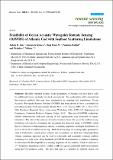| dc.contributor.author | Ignisca, Anamaria | |
| dc.contributor.author | Ratilal, Purnima | |
| dc.contributor.author | Makris, Nicholas | |
| dc.contributor.author | Jain, Ankita Deepak | |
| dc.contributor.author | Yi, Dong Hoon | |
| dc.date.accessioned | 2015-04-01T15:21:45Z | |
| dc.date.available | 2015-04-01T15:21:45Z | |
| dc.date.issued | 2013-12 | |
| dc.date.submitted | 2013-12 | |
| dc.identifier.issn | 2072-4292 | |
| dc.identifier.uri | http://hdl.handle.net/1721.1/96301 | |
| dc.description.abstract | Recently reported declines in the population of Atlantic cod have led to calls for additional survey methods for stock assessments. In combination with conventional line-transect methods that may have ambiguities in sampling fish populations, Ocean Acoustic Waveguide Remote Sensing (OAWRS) has been shown to have a potential for providing accurate stock assessments (Makris N.C., et al. Science 2009, 323, 1,734–1,737; 54th Northeast Regional Stock Assessment Workshop (54th SAW) US Department of Commerce, Northeast Fisheries Science Center, 2012). The use of OAWRS technology enables instantaneous wide-area sensing of fish aggregations over thousands of square kilometers. The ratio of the intensity of scattered returns from fish versus the seafloor in any resolution cell typically determines the maximum fish detection range of OAWRS, which then is a function of fish population density, scattering amplitude and depth distribution, as well as the level of seafloor scattering. With the knowledge of oceanographic parameters, such as bathymetry, sound speed structure and attenuation, we find that a Rayleigh–Born volume scattering approach can be used to efficiently and accurately estimate seafloor scattering over wide areas. From hundreds of OAWRS measurements of seafloor scattering, we determine the Rayleigh–Born scattering amplitude of the seafloor, which we find has a ƒ[superscript 2,4] frequency dependence below roughly 2 kHz in typical continental shelf environments along the US northeast coast. We then find that it is possible to robustly detect cod aggregations across frequencies at and near swim bladder resonance for observed spawningconfigurations along the U.S. northeast coast, roughly the two octave range 150–600 Hzfor water depths up to roughly 100 m. This frequency range is also optimal for long-rangeocean acoustic waveguide propagation, because it enables multimodal acoustic waveguidepropagation with minimal acoustic absorption and forward scattering losses. As the sensingfrequency moves away from the resonance peak, OAWRS detection of cod becomesincreasingly less optimal, due to a rapid decrease in cod scattering amplitude. In otherenvironments where cod depth may be greater, the optimal frequencies for cod detectionare expected to increase with swim bladder resonance frequency. | en_US |
| dc.description.sponsorship | National Oceanographic Partnership Program (U.S.) | en_US |
| dc.description.sponsorship | United States. Office of Naval Research | en_US |
| dc.description.sponsorship | United States. National Oceanic and Atmospheric Administration | en_US |
| dc.language.iso | en_US | |
| dc.publisher | MDPI AG | en_US |
| dc.relation.isversionof | http://dx.doi.org/10.3390/rs6010180 | en_US |
| dc.rights | Creative Commons Attribution | en_US |
| dc.rights.uri | http://creativecommons.org/licenses/by/3.0/ | en_US |
| dc.source | MDPI Publishing | en_US |
| dc.title | Feasibility of Ocean Acoustic Waveguide Remote Sensing (OAWRS) of Atlantic Cod with Seafloor Scattering Limitations | en_US |
| dc.type | Article | en_US |
| dc.identifier.citation | Jain, Ankita, Anamaria Ignisca, Dong Hoon Yi, Purnima Ratilal, and Nicholas Makris. “Feasibility of Ocean Acoustic Waveguide Remote Sensing (OAWRS) of Atlantic Cod with Seafloor Scattering Limitations.” Remote Sensing 6, no. 1 (December 20, 2013): 180–208. | en_US |
| dc.contributor.department | Massachusetts Institute of Technology. Department of Mechanical Engineering | en_US |
| dc.contributor.mitauthor | Jain, Ankita Deepak | en_US |
| dc.contributor.mitauthor | Ignisca, Anamaria | en_US |
| dc.contributor.mitauthor | Yi, Dong Hoon | en_US |
| dc.contributor.mitauthor | Makris, Nicholas | en_US |
| dc.relation.journal | Remote Sensing | en_US |
| dc.eprint.version | Final published version | en_US |
| dc.type.uri | http://purl.org/eprint/type/JournalArticle | en_US |
| eprint.status | http://purl.org/eprint/status/PeerReviewed | en_US |
| dspace.orderedauthors | Jain, Ankita; Ignisca, Anamaria; Yi, Dong Hoon; Ratilal, Purnima; Makris, Nicholas | en_US |
| dc.identifier.orcid | https://orcid.org/0000-0002-0261-4482 | |
| dc.identifier.orcid | https://orcid.org/0000-0003-4369-296X | |
| mit.license | PUBLISHER_CC | en_US |
| mit.metadata.status | Complete | |
